Case Study: Exploring Key Components of Effective Teams in Organizational Behavior
VerifiedAdded on 2022/11/28
|9
|2092
|198
AI Summary
This case study explores the key components of effective teams in organizational behavior, focusing on a leading university in Australia. It discusses the importance of commitment, interdependence, interpersonal skills, open communication, defined work processes, constructive conflict resolution, and appropriate team composition. The study also highlights the factors that contribute to team success and failure, and provides insights on how educators can prevent team failures and how to solve conflicts in teams.
Contribute Materials
Your contribution can guide someone’s learning journey. Share your
documents today.
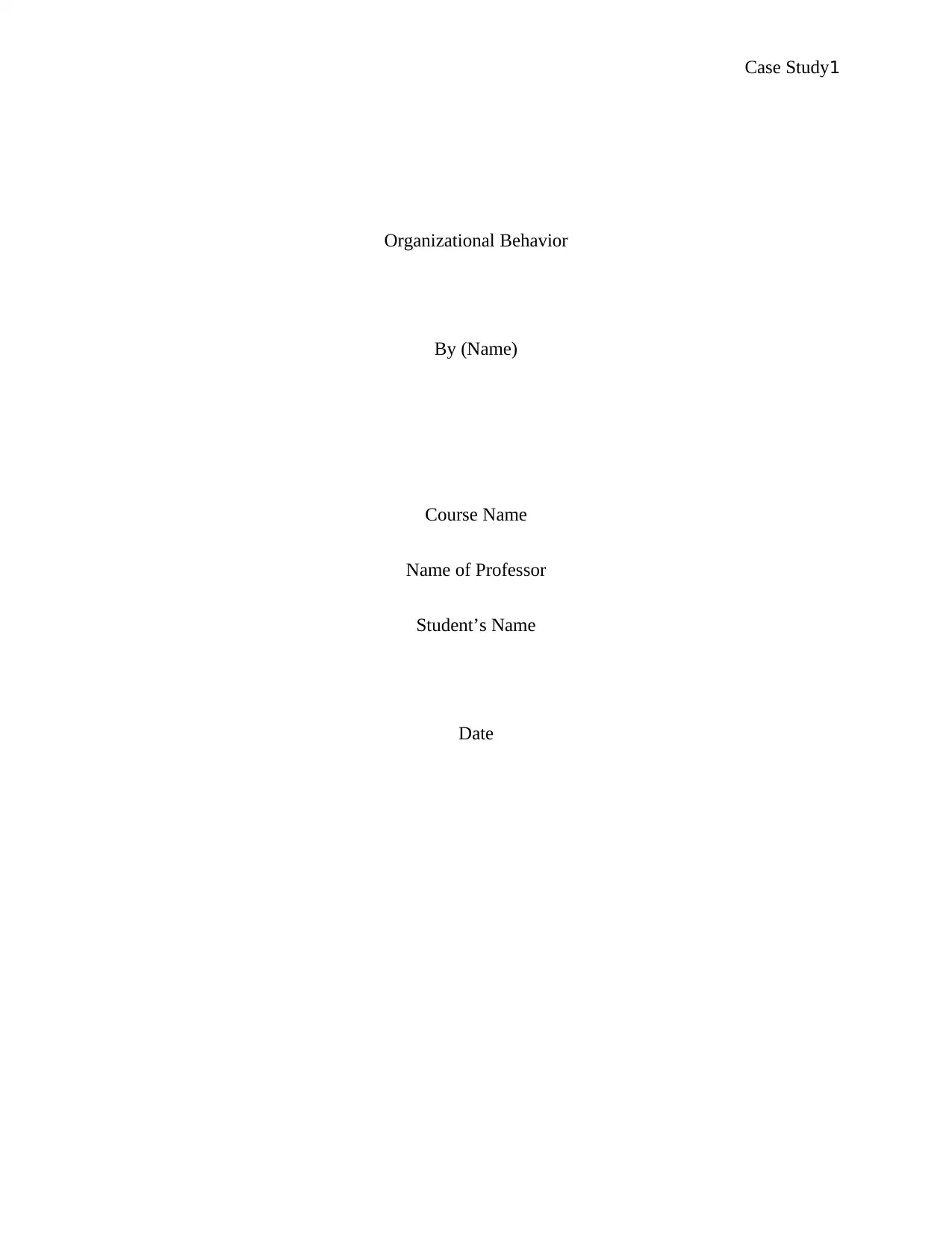
Case Study1
Organizational Behavior
By (Name)
Course Name
Name of Professor
Student’s Name
Date
Organizational Behavior
By (Name)
Course Name
Name of Professor
Student’s Name
Date
Secure Best Marks with AI Grader
Need help grading? Try our AI Grader for instant feedback on your assignments.
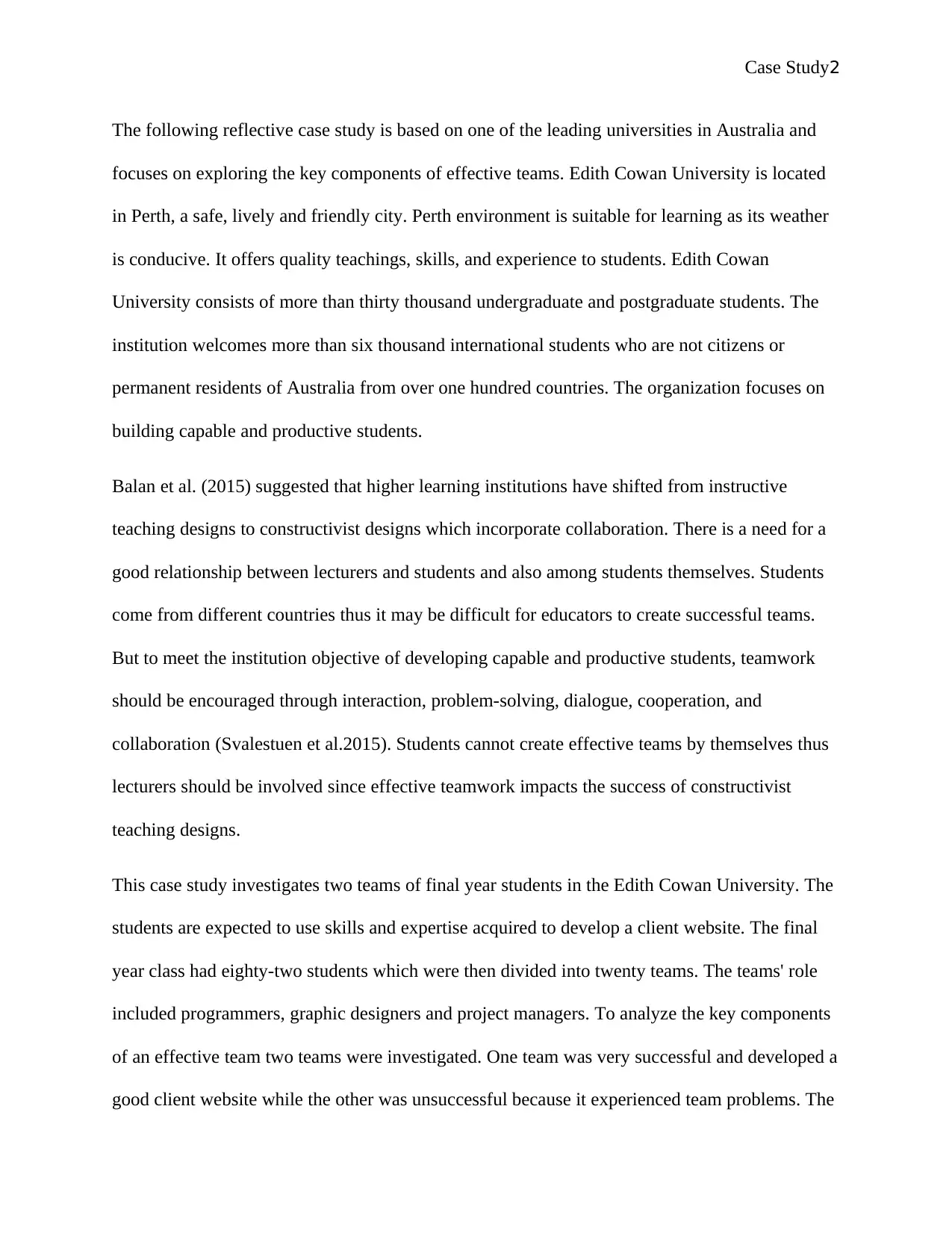
Case Study2
The following reflective case study is based on one of the leading universities in Australia and
focuses on exploring the key components of effective teams. Edith Cowan University is located
in Perth, a safe, lively and friendly city. Perth environment is suitable for learning as its weather
is conducive. It offers quality teachings, skills, and experience to students. Edith Cowan
University consists of more than thirty thousand undergraduate and postgraduate students. The
institution welcomes more than six thousand international students who are not citizens or
permanent residents of Australia from over one hundred countries. The organization focuses on
building capable and productive students.
Balan et al. (2015) suggested that higher learning institutions have shifted from instructive
teaching designs to constructivist designs which incorporate collaboration. There is a need for a
good relationship between lecturers and students and also among students themselves. Students
come from different countries thus it may be difficult for educators to create successful teams.
But to meet the institution objective of developing capable and productive students, teamwork
should be encouraged through interaction, problem-solving, dialogue, cooperation, and
collaboration (Svalestuen et al.2015). Students cannot create effective teams by themselves thus
lecturers should be involved since effective teamwork impacts the success of constructivist
teaching designs.
This case study investigates two teams of final year students in the Edith Cowan University. The
students are expected to use skills and expertise acquired to develop a client website. The final
year class had eighty-two students which were then divided into twenty teams. The teams' role
included programmers, graphic designers and project managers. To analyze the key components
of an effective team two teams were investigated. One team was very successful and developed a
good client website while the other was unsuccessful because it experienced team problems. The
The following reflective case study is based on one of the leading universities in Australia and
focuses on exploring the key components of effective teams. Edith Cowan University is located
in Perth, a safe, lively and friendly city. Perth environment is suitable for learning as its weather
is conducive. It offers quality teachings, skills, and experience to students. Edith Cowan
University consists of more than thirty thousand undergraduate and postgraduate students. The
institution welcomes more than six thousand international students who are not citizens or
permanent residents of Australia from over one hundred countries. The organization focuses on
building capable and productive students.
Balan et al. (2015) suggested that higher learning institutions have shifted from instructive
teaching designs to constructivist designs which incorporate collaboration. There is a need for a
good relationship between lecturers and students and also among students themselves. Students
come from different countries thus it may be difficult for educators to create successful teams.
But to meet the institution objective of developing capable and productive students, teamwork
should be encouraged through interaction, problem-solving, dialogue, cooperation, and
collaboration (Svalestuen et al.2015). Students cannot create effective teams by themselves thus
lecturers should be involved since effective teamwork impacts the success of constructivist
teaching designs.
This case study investigates two teams of final year students in the Edith Cowan University. The
students are expected to use skills and expertise acquired to develop a client website. The final
year class had eighty-two students which were then divided into twenty teams. The teams' role
included programmers, graphic designers and project managers. To analyze the key components
of an effective team two teams were investigated. One team was very successful and developed a
good client website while the other was unsuccessful because it experienced team problems. The
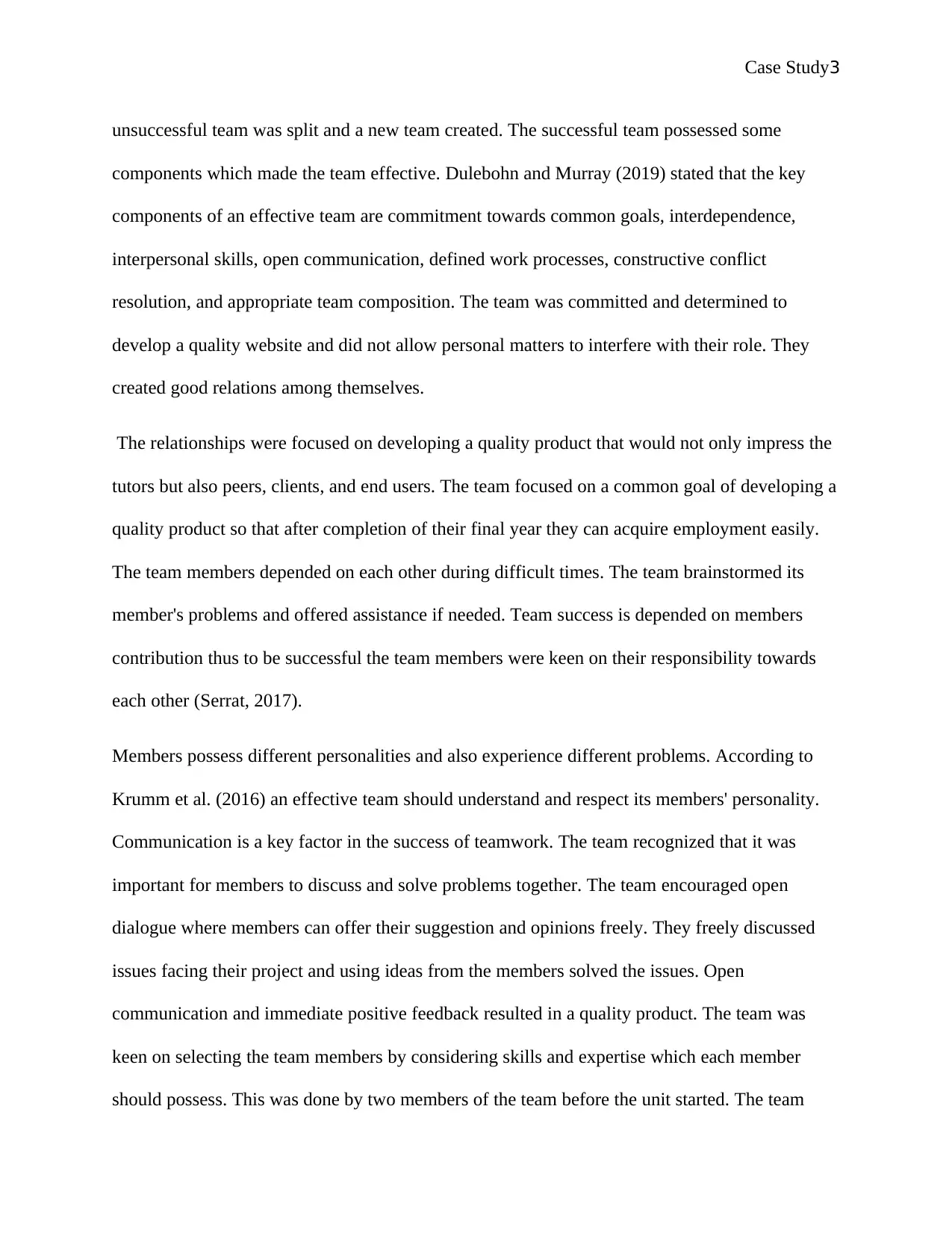
Case Study3
unsuccessful team was split and a new team created. The successful team possessed some
components which made the team effective. Dulebohn and Murray (2019) stated that the key
components of an effective team are commitment towards common goals, interdependence,
interpersonal skills, open communication, defined work processes, constructive conflict
resolution, and appropriate team composition. The team was committed and determined to
develop a quality website and did not allow personal matters to interfere with their role. They
created good relations among themselves.
The relationships were focused on developing a quality product that would not only impress the
tutors but also peers, clients, and end users. The team focused on a common goal of developing a
quality product so that after completion of their final year they can acquire employment easily.
The team members depended on each other during difficult times. The team brainstormed its
member's problems and offered assistance if needed. Team success is depended on members
contribution thus to be successful the team members were keen on their responsibility towards
each other (Serrat, 2017).
Members possess different personalities and also experience different problems. According to
Krumm et al. (2016) an effective team should understand and respect its members' personality.
Communication is a key factor in the success of teamwork. The team recognized that it was
important for members to discuss and solve problems together. The team encouraged open
dialogue where members can offer their suggestion and opinions freely. They freely discussed
issues facing their project and using ideas from the members solved the issues. Open
communication and immediate positive feedback resulted in a quality product. The team was
keen on selecting the team members by considering skills and expertise which each member
should possess. This was done by two members of the team before the unit started. The team
unsuccessful team was split and a new team created. The successful team possessed some
components which made the team effective. Dulebohn and Murray (2019) stated that the key
components of an effective team are commitment towards common goals, interdependence,
interpersonal skills, open communication, defined work processes, constructive conflict
resolution, and appropriate team composition. The team was committed and determined to
develop a quality website and did not allow personal matters to interfere with their role. They
created good relations among themselves.
The relationships were focused on developing a quality product that would not only impress the
tutors but also peers, clients, and end users. The team focused on a common goal of developing a
quality product so that after completion of their final year they can acquire employment easily.
The team members depended on each other during difficult times. The team brainstormed its
member's problems and offered assistance if needed. Team success is depended on members
contribution thus to be successful the team members were keen on their responsibility towards
each other (Serrat, 2017).
Members possess different personalities and also experience different problems. According to
Krumm et al. (2016) an effective team should understand and respect its members' personality.
Communication is a key factor in the success of teamwork. The team recognized that it was
important for members to discuss and solve problems together. The team encouraged open
dialogue where members can offer their suggestion and opinions freely. They freely discussed
issues facing their project and using ideas from the members solved the issues. Open
communication and immediate positive feedback resulted in a quality product. The team was
keen on selecting the team members by considering skills and expertise which each member
should possess. This was done by two members of the team before the unit started. The team
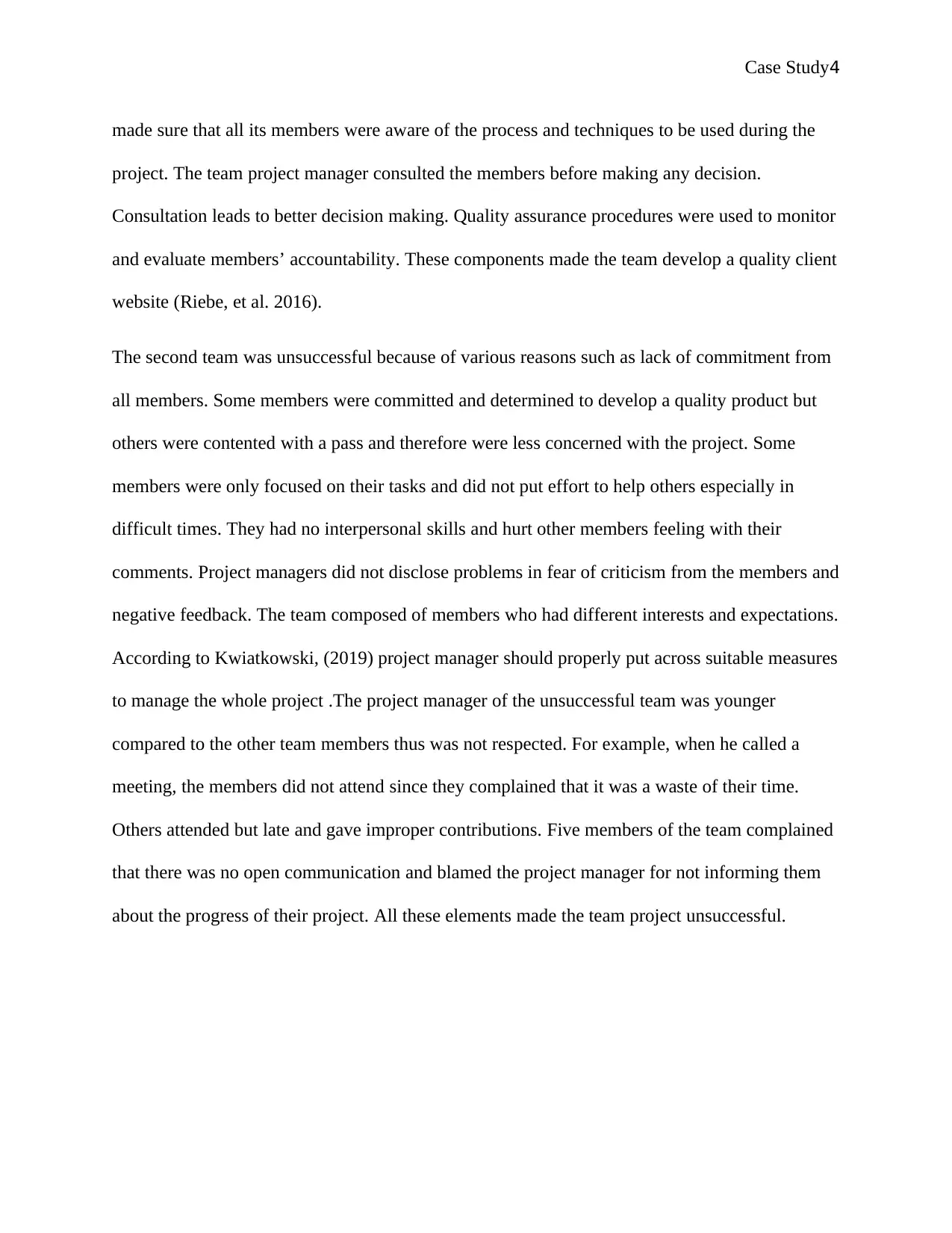
Case Study4
made sure that all its members were aware of the process and techniques to be used during the
project. The team project manager consulted the members before making any decision.
Consultation leads to better decision making. Quality assurance procedures were used to monitor
and evaluate members’ accountability. These components made the team develop a quality client
website (Riebe, et al. 2016).
The second team was unsuccessful because of various reasons such as lack of commitment from
all members. Some members were committed and determined to develop a quality product but
others were contented with a pass and therefore were less concerned with the project. Some
members were only focused on their tasks and did not put effort to help others especially in
difficult times. They had no interpersonal skills and hurt other members feeling with their
comments. Project managers did not disclose problems in fear of criticism from the members and
negative feedback. The team composed of members who had different interests and expectations.
According to Kwiatkowski, (2019) project manager should properly put across suitable measures
to manage the whole project .The project manager of the unsuccessful team was younger
compared to the other team members thus was not respected. For example, when he called a
meeting, the members did not attend since they complained that it was a waste of their time.
Others attended but late and gave improper contributions. Five members of the team complained
that there was no open communication and blamed the project manager for not informing them
about the progress of their project. All these elements made the team project unsuccessful.
made sure that all its members were aware of the process and techniques to be used during the
project. The team project manager consulted the members before making any decision.
Consultation leads to better decision making. Quality assurance procedures were used to monitor
and evaluate members’ accountability. These components made the team develop a quality client
website (Riebe, et al. 2016).
The second team was unsuccessful because of various reasons such as lack of commitment from
all members. Some members were committed and determined to develop a quality product but
others were contented with a pass and therefore were less concerned with the project. Some
members were only focused on their tasks and did not put effort to help others especially in
difficult times. They had no interpersonal skills and hurt other members feeling with their
comments. Project managers did not disclose problems in fear of criticism from the members and
negative feedback. The team composed of members who had different interests and expectations.
According to Kwiatkowski, (2019) project manager should properly put across suitable measures
to manage the whole project .The project manager of the unsuccessful team was younger
compared to the other team members thus was not respected. For example, when he called a
meeting, the members did not attend since they complained that it was a waste of their time.
Others attended but late and gave improper contributions. Five members of the team complained
that there was no open communication and blamed the project manager for not informing them
about the progress of their project. All these elements made the team project unsuccessful.
Secure Best Marks with AI Grader
Need help grading? Try our AI Grader for instant feedback on your assignments.
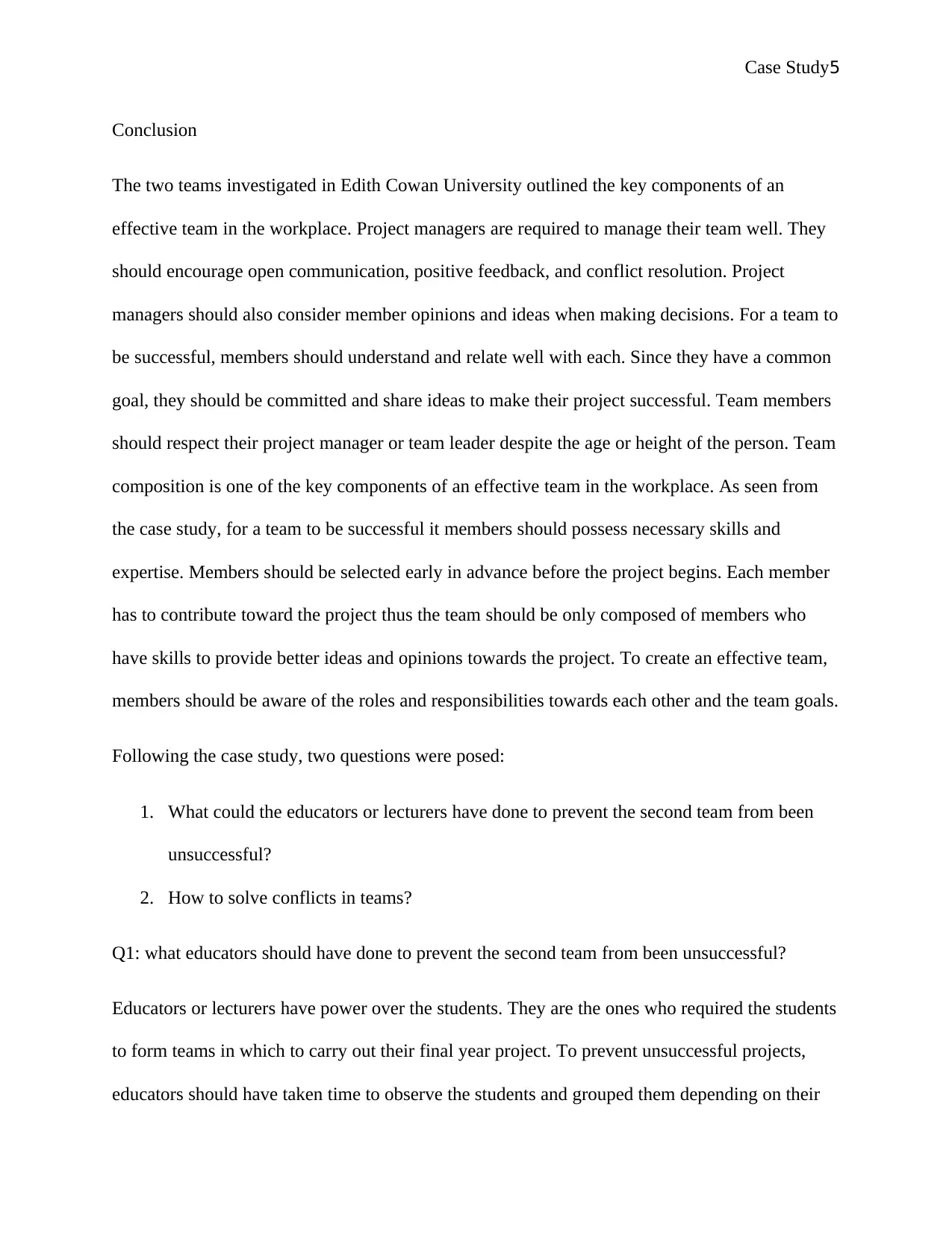
Case Study5
Conclusion
The two teams investigated in Edith Cowan University outlined the key components of an
effective team in the workplace. Project managers are required to manage their team well. They
should encourage open communication, positive feedback, and conflict resolution. Project
managers should also consider member opinions and ideas when making decisions. For a team to
be successful, members should understand and relate well with each. Since they have a common
goal, they should be committed and share ideas to make their project successful. Team members
should respect their project manager or team leader despite the age or height of the person. Team
composition is one of the key components of an effective team in the workplace. As seen from
the case study, for a team to be successful it members should possess necessary skills and
expertise. Members should be selected early in advance before the project begins. Each member
has to contribute toward the project thus the team should be only composed of members who
have skills to provide better ideas and opinions towards the project. To create an effective team,
members should be aware of the roles and responsibilities towards each other and the team goals.
Following the case study, two questions were posed:
1. What could the educators or lecturers have done to prevent the second team from been
unsuccessful?
2. How to solve conflicts in teams?
Q1: what educators should have done to prevent the second team from been unsuccessful?
Educators or lecturers have power over the students. They are the ones who required the students
to form teams in which to carry out their final year project. To prevent unsuccessful projects,
educators should have taken time to observe the students and grouped them depending on their
Conclusion
The two teams investigated in Edith Cowan University outlined the key components of an
effective team in the workplace. Project managers are required to manage their team well. They
should encourage open communication, positive feedback, and conflict resolution. Project
managers should also consider member opinions and ideas when making decisions. For a team to
be successful, members should understand and relate well with each. Since they have a common
goal, they should be committed and share ideas to make their project successful. Team members
should respect their project manager or team leader despite the age or height of the person. Team
composition is one of the key components of an effective team in the workplace. As seen from
the case study, for a team to be successful it members should possess necessary skills and
expertise. Members should be selected early in advance before the project begins. Each member
has to contribute toward the project thus the team should be only composed of members who
have skills to provide better ideas and opinions towards the project. To create an effective team,
members should be aware of the roles and responsibilities towards each other and the team goals.
Following the case study, two questions were posed:
1. What could the educators or lecturers have done to prevent the second team from been
unsuccessful?
2. How to solve conflicts in teams?
Q1: what educators should have done to prevent the second team from been unsuccessful?
Educators or lecturers have power over the students. They are the ones who required the students
to form teams in which to carry out their final year project. To prevent unsuccessful projects,
educators should have taken time to observe the students and grouped them depending on their
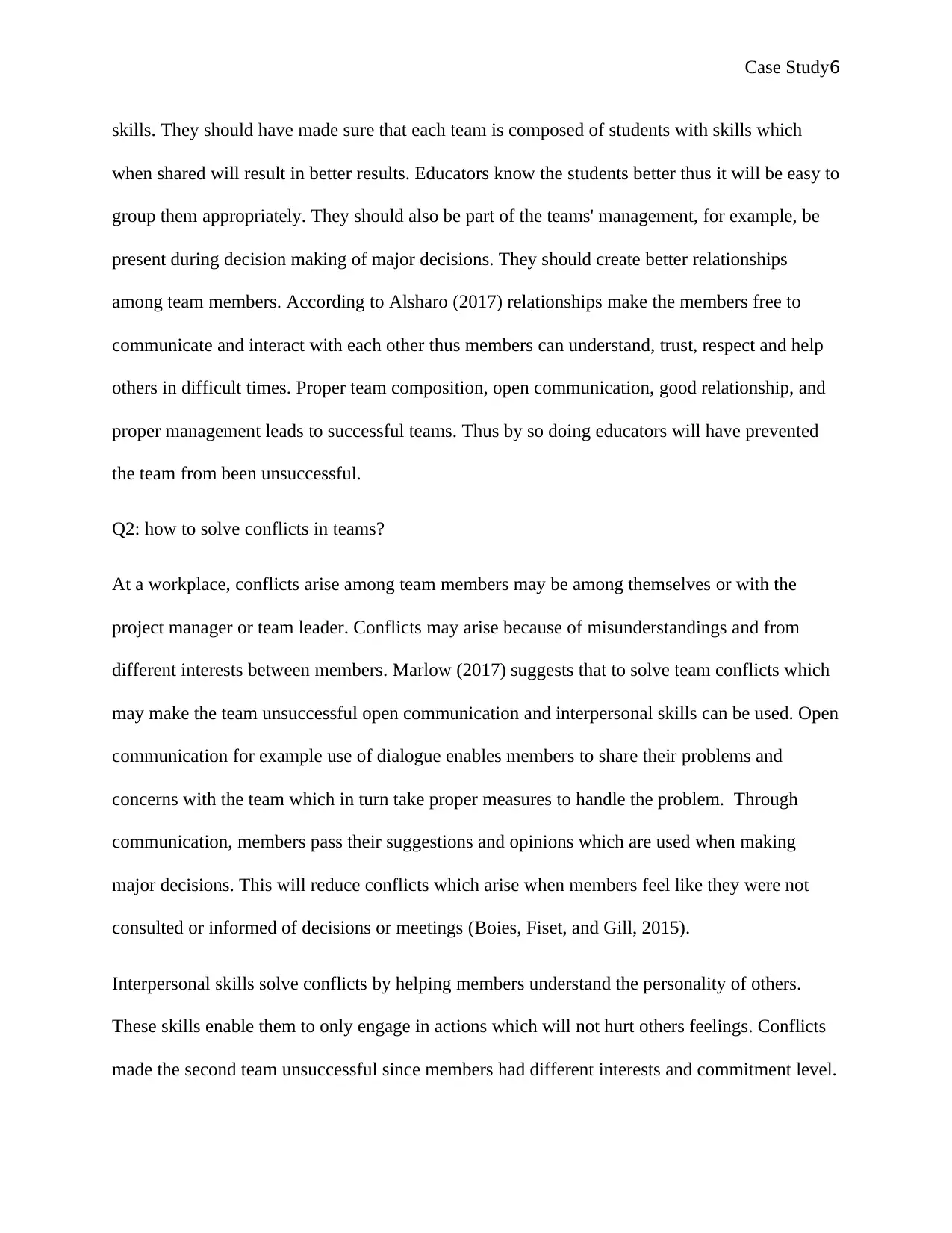
Case Study6
skills. They should have made sure that each team is composed of students with skills which
when shared will result in better results. Educators know the students better thus it will be easy to
group them appropriately. They should also be part of the teams' management, for example, be
present during decision making of major decisions. They should create better relationships
among team members. According to Alsharo (2017) relationships make the members free to
communicate and interact with each other thus members can understand, trust, respect and help
others in difficult times. Proper team composition, open communication, good relationship, and
proper management leads to successful teams. Thus by so doing educators will have prevented
the team from been unsuccessful.
Q2: how to solve conflicts in teams?
At a workplace, conflicts arise among team members may be among themselves or with the
project manager or team leader. Conflicts may arise because of misunderstandings and from
different interests between members. Marlow (2017) suggests that to solve team conflicts which
may make the team unsuccessful open communication and interpersonal skills can be used. Open
communication for example use of dialogue enables members to share their problems and
concerns with the team which in turn take proper measures to handle the problem. Through
communication, members pass their suggestions and opinions which are used when making
major decisions. This will reduce conflicts which arise when members feel like they were not
consulted or informed of decisions or meetings (Boies, Fiset, and Gill, 2015).
Interpersonal skills solve conflicts by helping members understand the personality of others.
These skills enable them to only engage in actions which will not hurt others feelings. Conflicts
made the second team unsuccessful since members had different interests and commitment level.
skills. They should have made sure that each team is composed of students with skills which
when shared will result in better results. Educators know the students better thus it will be easy to
group them appropriately. They should also be part of the teams' management, for example, be
present during decision making of major decisions. They should create better relationships
among team members. According to Alsharo (2017) relationships make the members free to
communicate and interact with each other thus members can understand, trust, respect and help
others in difficult times. Proper team composition, open communication, good relationship, and
proper management leads to successful teams. Thus by so doing educators will have prevented
the team from been unsuccessful.
Q2: how to solve conflicts in teams?
At a workplace, conflicts arise among team members may be among themselves or with the
project manager or team leader. Conflicts may arise because of misunderstandings and from
different interests between members. Marlow (2017) suggests that to solve team conflicts which
may make the team unsuccessful open communication and interpersonal skills can be used. Open
communication for example use of dialogue enables members to share their problems and
concerns with the team which in turn take proper measures to handle the problem. Through
communication, members pass their suggestions and opinions which are used when making
major decisions. This will reduce conflicts which arise when members feel like they were not
consulted or informed of decisions or meetings (Boies, Fiset, and Gill, 2015).
Interpersonal skills solve conflicts by helping members understand the personality of others.
These skills enable them to only engage in actions which will not hurt others feelings. Conflicts
made the second team unsuccessful since members had different interests and commitment level.
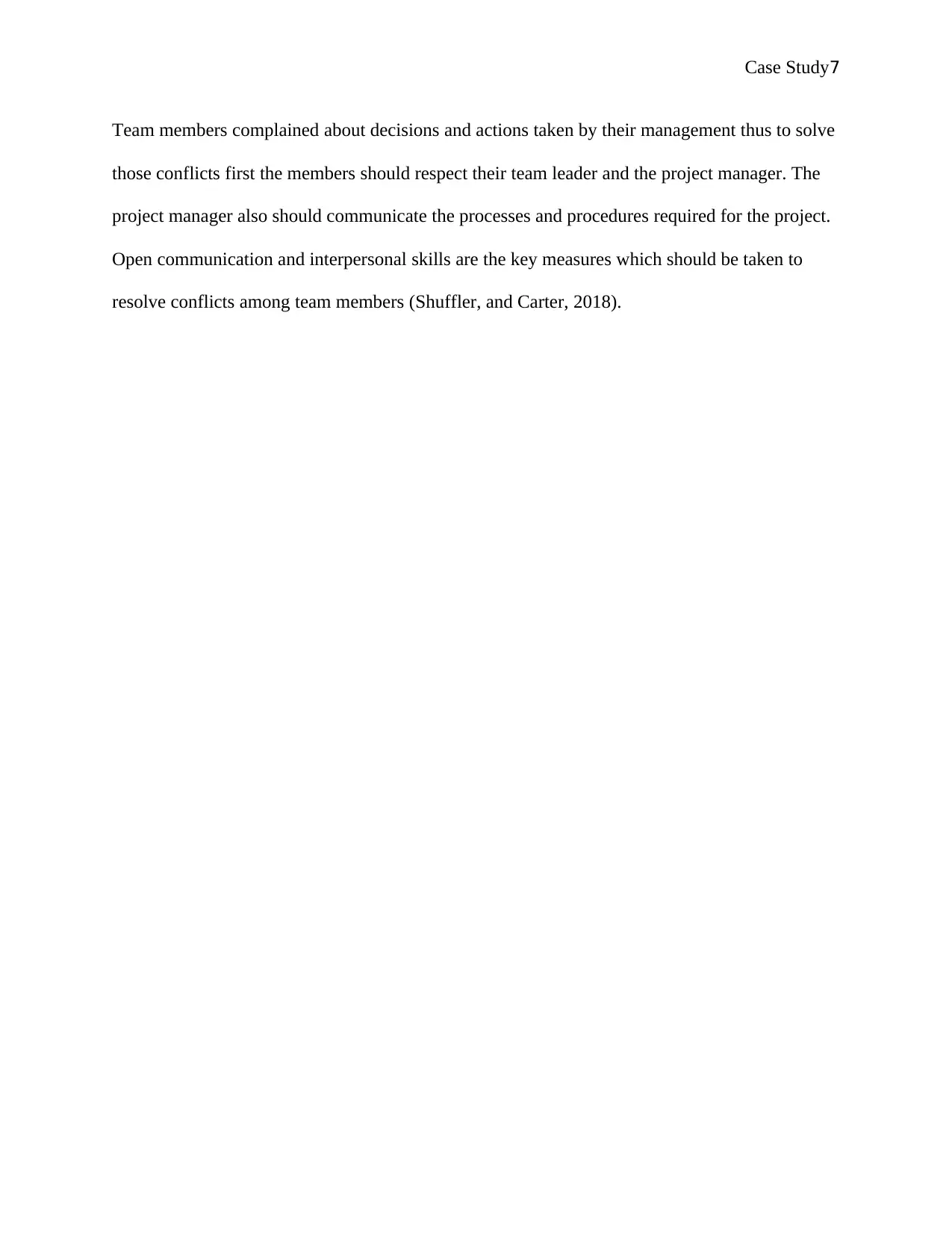
Case Study7
Team members complained about decisions and actions taken by their management thus to solve
those conflicts first the members should respect their team leader and the project manager. The
project manager also should communicate the processes and procedures required for the project.
Open communication and interpersonal skills are the key measures which should be taken to
resolve conflicts among team members (Shuffler, and Carter, 2018).
Team members complained about decisions and actions taken by their management thus to solve
those conflicts first the members should respect their team leader and the project manager. The
project manager also should communicate the processes and procedures required for the project.
Open communication and interpersonal skills are the key measures which should be taken to
resolve conflicts among team members (Shuffler, and Carter, 2018).
Paraphrase This Document
Need a fresh take? Get an instant paraphrase of this document with our AI Paraphraser
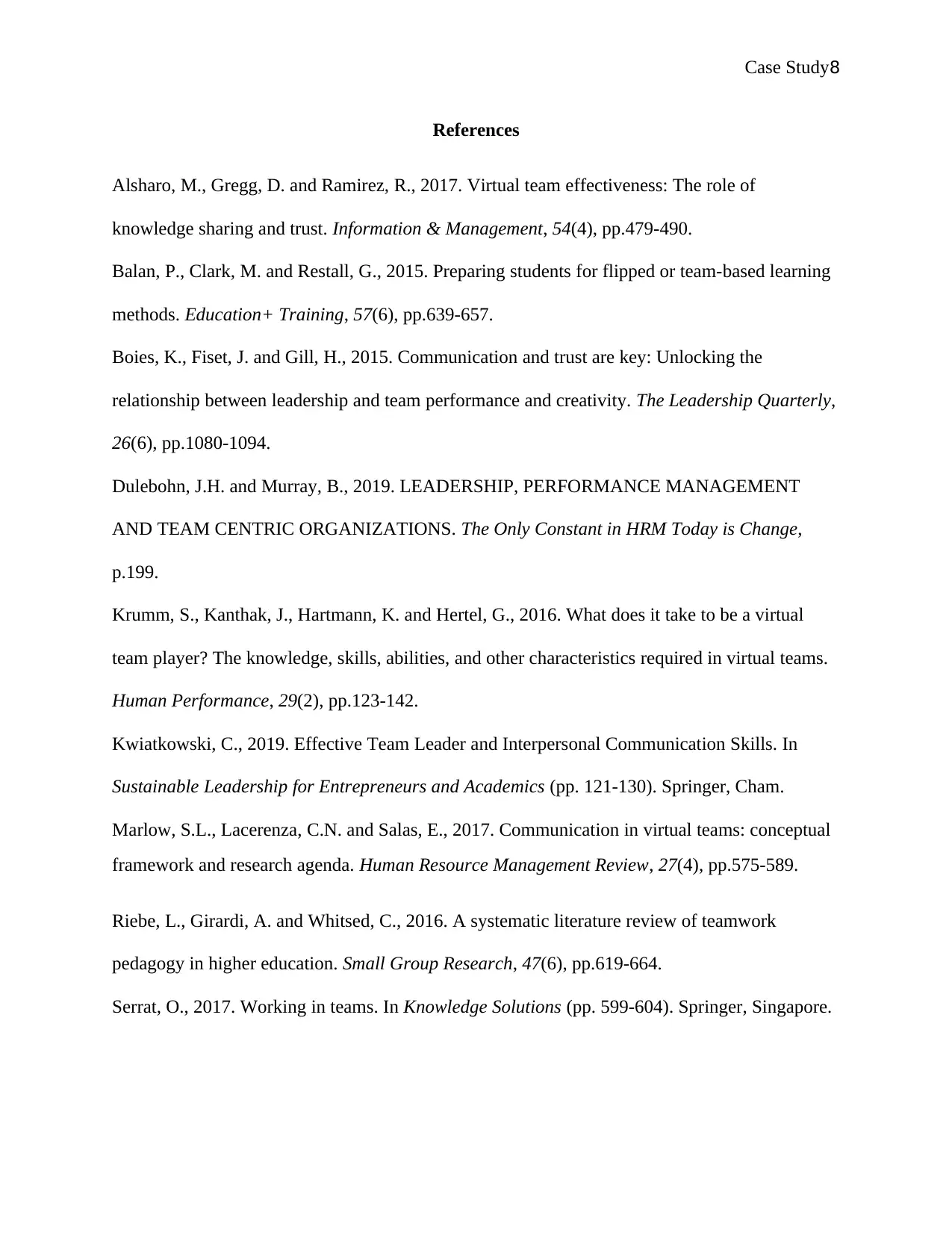
Case Study8
References
Alsharo, M., Gregg, D. and Ramirez, R., 2017. Virtual team effectiveness: The role of
knowledge sharing and trust. Information & Management, 54(4), pp.479-490.
Balan, P., Clark, M. and Restall, G., 2015. Preparing students for flipped or team-based learning
methods. Education+ Training, 57(6), pp.639-657.
Boies, K., Fiset, J. and Gill, H., 2015. Communication and trust are key: Unlocking the
relationship between leadership and team performance and creativity. The Leadership Quarterly,
26(6), pp.1080-1094.
Dulebohn, J.H. and Murray, B., 2019. LEADERSHIP, PERFORMANCE MANAGEMENT
AND TEAM CENTRIC ORGANIZATIONS. The Only Constant in HRM Today is Change,
p.199.
Krumm, S., Kanthak, J., Hartmann, K. and Hertel, G., 2016. What does it take to be a virtual
team player? The knowledge, skills, abilities, and other characteristics required in virtual teams.
Human Performance, 29(2), pp.123-142.
Kwiatkowski, C., 2019. Effective Team Leader and Interpersonal Communication Skills. In
Sustainable Leadership for Entrepreneurs and Academics (pp. 121-130). Springer, Cham.
Marlow, S.L., Lacerenza, C.N. and Salas, E., 2017. Communication in virtual teams: conceptual
framework and research agenda. Human Resource Management Review, 27(4), pp.575-589.
Riebe, L., Girardi, A. and Whitsed, C., 2016. A systematic literature review of teamwork
pedagogy in higher education. Small Group Research, 47(6), pp.619-664.
Serrat, O., 2017. Working in teams. In Knowledge Solutions (pp. 599-604). Springer, Singapore.
References
Alsharo, M., Gregg, D. and Ramirez, R., 2017. Virtual team effectiveness: The role of
knowledge sharing and trust. Information & Management, 54(4), pp.479-490.
Balan, P., Clark, M. and Restall, G., 2015. Preparing students for flipped or team-based learning
methods. Education+ Training, 57(6), pp.639-657.
Boies, K., Fiset, J. and Gill, H., 2015. Communication and trust are key: Unlocking the
relationship between leadership and team performance and creativity. The Leadership Quarterly,
26(6), pp.1080-1094.
Dulebohn, J.H. and Murray, B., 2019. LEADERSHIP, PERFORMANCE MANAGEMENT
AND TEAM CENTRIC ORGANIZATIONS. The Only Constant in HRM Today is Change,
p.199.
Krumm, S., Kanthak, J., Hartmann, K. and Hertel, G., 2016. What does it take to be a virtual
team player? The knowledge, skills, abilities, and other characteristics required in virtual teams.
Human Performance, 29(2), pp.123-142.
Kwiatkowski, C., 2019. Effective Team Leader and Interpersonal Communication Skills. In
Sustainable Leadership for Entrepreneurs and Academics (pp. 121-130). Springer, Cham.
Marlow, S.L., Lacerenza, C.N. and Salas, E., 2017. Communication in virtual teams: conceptual
framework and research agenda. Human Resource Management Review, 27(4), pp.575-589.
Riebe, L., Girardi, A. and Whitsed, C., 2016. A systematic literature review of teamwork
pedagogy in higher education. Small Group Research, 47(6), pp.619-664.
Serrat, O., 2017. Working in teams. In Knowledge Solutions (pp. 599-604). Springer, Singapore.

Case Study9
Shuffler, M.L. and Carter, D.R., 2018. Teamwork situated in multiteam systems: Key lessons
learned and future opportunities. American Psychologist, 73(4), p.390.
Svalestuen, F., Frøystad, K., Drevland, F., Ahmad, S., Lohne, J. and Lædre, O., 2015. Key
elements to an effective building design team. Procedia Computer Science, 64, pp.838-843.
Shuffler, M.L. and Carter, D.R., 2018. Teamwork situated in multiteam systems: Key lessons
learned and future opportunities. American Psychologist, 73(4), p.390.
Svalestuen, F., Frøystad, K., Drevland, F., Ahmad, S., Lohne, J. and Lædre, O., 2015. Key
elements to an effective building design team. Procedia Computer Science, 64, pp.838-843.
1 out of 9
Related Documents
Your All-in-One AI-Powered Toolkit for Academic Success.
+13062052269
info@desklib.com
Available 24*7 on WhatsApp / Email
![[object Object]](/_next/static/media/star-bottom.7253800d.svg)
Unlock your academic potential
© 2024 | Zucol Services PVT LTD | All rights reserved.





